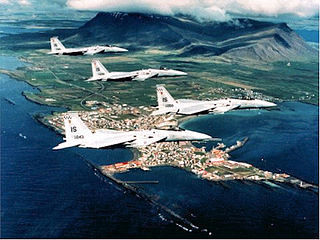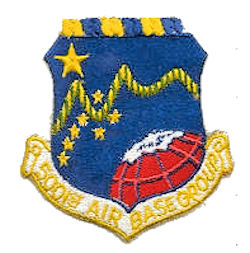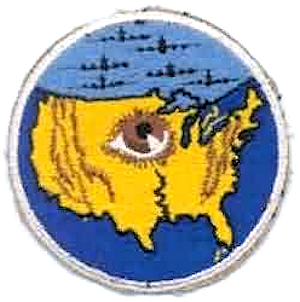
The Lockheed F-94 Starfire is a first-generation jet powered all-weather day/night interceptor aircraft designed and produced by Lockheed Corporation. It was the first operational United States Air Force (USAF) fighter equipped with an afterburner as well as being the first jet-powered all-weather fighter to enter combat during the Korean War.

Kincheloe Air Force Base was a United States Air Force (USAF) base during the Cold War. Built in the Upper Peninsula of Michigan in 1943 during World War II, the base was in service until 1977.

The McDonnell CF-101 Voodoo was an all-weather interceptor aircraft operated by the Royal Canadian Air Force and the Canadian Forces between 1961 and 1984. They were manufactured by the McDonnell Aircraft Corporation of St. Louis, Missouri for the United States Air Force, and later sold to Canada. CF-101s replaced the obsolete Avro CF-100 Canuck in the RCAF's all-weather fighter squadrons. The Voodoo's primary armament was nuclear AIR-2A Genie unguided air-to-air rockets, and there was significant political controversy in Canada about their adoption. Although they never fired a weapon in wartime, the CF-101 served as Canada's primary means of air defence from Quick Reaction Alert facilities at Canadian airbases. The CF-101s were retired in the 1980s and replaced with McDonnell Douglas CF-18 Hornet fighters. Many examples are preserved in museums and parks in Canada and the United States.

Ground-controlled interception (GCI) is an air defence tactic whereby one or more radar stations or other observational stations are linked to a command communications centre which guides interceptor aircraft to an airborne target. This tactic was pioneered during World War I by the London Air Defence Area organization, which became the Royal Air Force's Dowding system in World War II, the first national-scale system. The Luftwaffe introduced similar systems during the war, but most other combatants did not suffer the same threat of air attack and did not develop complex systems like these until the Cold War era.
Operation Sky Shield, properly Exercise Sky Shield, was a series of three large-scale military exercises conducted in the United States and Canada in 1960, 1961, and 1962 by NORAD Command and CONAD Command to test defenses against an air attack from the Soviet Union. The tests were intended to ensure that any attacks over the American–Canadian border or coastlines would be detected and then stopped.

The 113th Wing, known as the "Capital Guardians", is a unit of the District of Columbia Air National Guard, stationed at Joint Base Andrews, Maryland. If activated to federal service, the fighter portion of the Wing is gained by the United States Air Force's Air Combat Command, while the airlift portion is gained by Air Mobility Command.

The 182d Fighter Squadron is a unit of the Texas Air National Guard 149th Fighter Wing located at Kelly Field Annex, Joint Base San Antonio, Texas. The 149th is equipped with the F-16C/D Fighting Falcon.

The 136th Airlift Wing is a unit of the Texas Air National Guard, stationed at Naval Air Station Joint Reserve Base Fort Worth, Fort Worth, Texas. If activated to federal service, the wing is gained by the United States Air Force's Air Mobility Command (AMC).

The 178th Attack Squadron is a unit of the North Dakota Air National Guard 119th Wing located at Fargo Air National Guard Base, North Dakota. The 178th is equipped with the MQ-9 Reaper.

The 136th Attack Squadron is a unit of the New York Air National Guard 107th Attack Wing located at Niagara Falls Joint Air Reserve Station, New York. The 136th is equipped with the MQ-9 Reaper. If activated to federal service, the Wing is gained by the United States Air Force's Air Combat Command.

The 133rd Air Refueling Squadron is a unit of the New Hampshire Air National Guard 157th Air Refueling Wing located at Pease Air National Guard Base, Portsmouth, New Hampshire, United States. The 133rd, which previously operated the KC-135 Stratotanker, received its first KC-46A Pegasus tanker on 8 August 2019.

The 62d Fighter Squadron is part of the United States Air Force 56th Operations Group at Luke Air Force Base, Arizona. It operates the Lockheed Martin F-35A Lightning II aircraft conducting advanced fighter training.

The 138th Attack Squadron is a unit of the New York Air National Guard's 174th Attack Wing located at Hancock Field Air National Guard Base in Syracuse, New York. The 138th is equipped with the MQ-9 Reaper Remotely Piloted Aircraft (RPA).

The 57th Fighter-Interceptor Squadron, also known as "The Black Knights of Keflavik", is an inactive United States Air Force unit. The 57 FIS was last stationed at Naval Air Station Keflavik, Iceland. It was inactivated on 1 March 1995.

The 5001st Composite Wing is an defunct United States Air Force organization. Throughout its existence, it was assigned to the Alaskan Air Command and stationed at Ladd Air Force Base, Alaska.

Quick Reaction Alert (QRA) is state of readiness and modus operandi of air defence maintained at all hours of the day by NATO air forces. The United States usually refers to Quick Reaction Alert as 'Airspace Control Alert'.

The 740th Aircraft Control and Warning Squadron AKA 740th AC&W Squadron is an inactive United States Air Force unit. It was last assigned to the, Air Defense Command, 29th Air Division, Great Falls Montana, stationed at Ellsworth Air Force Base, South Dakota. It was discontinued on 15 August 1962.

Lieutenant General Winton Whittier Marshall was a United States Air Force general and flying ace. He was deputy commander in chief, U.S. Readiness Command, with headquarters at MacDill Air Force Base in Florida before retiring in 1977.
In the armed forces, most often in military aviation and in land-based missile forces, an alert crew is a group of members of units and formations that maintains a group level of combat readiness. Although it sometimes encompasses the entire unit, today the term is more used for a set group of individuals.

On 25 May 1982, a Royal Air Force SEPECAT Jaguar of 14 Squadron crashed in farmland approximately 35 miles from its base, RAF Brüggen in Germany, having been accidentally hit by an air-to-air missile fired by another Royal Air Force aircraft, a McDonnell Douglas Phantom.



















